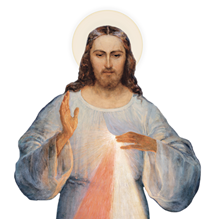
“More Brilliant than the Sun," a weekly series by Robert Stackpole, STD, Director of the John Paul II Institute of Divine Mercy
The series so far:
PART 1: The Plan of the Heart of Jesus to Drive Back the World's Darkness
PART 2: What Do We Really Mean By “The Heart of Jesus”?
PART 3: Devotion to the Heart of Jesus and its Roots in Holy Scripture
PART 4: The Heart of the Savior in the New Testament
PART 5: The Heart of Jesus Manifest in His Tender Affections and Compassionate Love
PART 6: The Heart of Jesus in the Garden and on the Cross
PART 7: From Easter Onward: The Heart of Jesus Lives in His Church
As we have seen so far in this web series, the devotion to the Sacred Heart leads us to a deeper appreciation of all the sufferings that our Savior endured, both in body and soul, flowing from His unfathomable love for his Heavenly Father and for us. A popular hymn from the 19th century tells us:
It is a thing most wonderful,
Almost too wonderful to be,
That God’s own Son should come from Heaven,
And die to save a child like me. …I cannot tell how He could love
A child so weak, so full of sin;
His love must be most wonderful,
If He could die my love to win. …But even could I see Him die,
I could but see a little part
Of that great love, which, like a fire,
Is always burning in His Heart.
Joys of the Sacred Heart
Let’s remember, however, that the sorrows of the Heart of Jesus are only half the story. The other half is something we all too often overlook: the joys of the Sacred Heart. For if His sorrows were deeper than those ever borne by anyone else, due to the boundless love in His Heart for lost and broken humanity — a love so rarely received and returned! — so, too, the joys of the Heart of Jesus must surpass those of any other human heart. In the Gospels, we catch glimpses of this in our Lord’s exultant prayer after the return of the 70 disciples from their mission:
In that same hour he rejoiced in the Holy Spirit and said, “I thank you, Father, Lord of heaven and earth, that you have hidden these things from the wise and understanding and revealed them to infants; yes, Father, for such was your gracious will” (Lk 10:21).
We see here Jesus rejoicing that the Gospel of the Kingdom had been preached by His disciples and welcomed by souls would with childlike trust.
In fact, the words and deeds of Jesus in the Gospels are laced with an underlying joy: a cheerful exuberance in the triumphant love of His Heavenly Father and the power of the Holy Spirit. Father Kubicki sums this up for us in his book Rediscovering Devotion to the Sacred Heart of Jesus (p. 74-76):
Jesus … came to bring life, a fullness of life that begins on earth with true joy and reaches its climax at the wedding feast of heaven, the eternal banquet [see Jn 10:10; 16:24].
What did Jesus most enjoy doing? What brought a smile to his face and filled him with joy? For a moment, put yourself in Jesus’ place and imagine what he felt when he healed people. Imagine the joy it gave his heart to see the man born blind look upon the world and all its beauties for the first time. It was the beauty of Jesus’ own face, the face of God incarnate, that the blind man probably saw first. His face surely lit up with the pleasure of sight. Imagine too how Jesus’ face reflected the man’s joy as he shared in it completely.
Or imagine the deaf man hearing music and birds singing for the first time, full of the pleasure of sound, and the new means of communication that was now possible for him. Or imagine the joy it gave Jesus to heal the leper, the man who had been isolated from humanity and from human touch for so long. …
Yet, though all these healings gave Jesus the greatest pleasure, I think there was something that brought him even greater joy. … Despite their wonderful healings, someday the eyes of the man who had been blind would close again in death, the ears of the man who had been deaf would be shut, and the skin of the man who had been a leper would turn to dust. Beyond performing mere physical healings, Jesus wanted most of all to touch the immortal part of the human person — the spirit. Spiritual healings had to give Jesus greater pleasure than physical healing. …
So Jesus tells them three stories about three things — a sheep, a coin, and a son. In each case the finding of what was lost gives the seeker greater joy (Luke 15). But the joy of finding something valuable on earth like a sheep or money, Jesus says, pales in comparison to the joy in heaven when a sinner, who was lost, is found. The joy in heaven with “rejoicing among the angels of God” (Lk 15:10) is the joy in Jesus’ heart when he can bring spiritual healing to people. It’s the joy that Jesus shares with the Father who sent the Son into the world not to condemn people, but to save them (see Jn 3:17).
Do not doubt for a moment that our Lord still feels boundless joy whenever He is able to bring a lost soul home to His Heart. The Risen Savior has the very same love for sinners burning in His Heart — and always will. Anglican spiritual writer Jeremy Taylor expressed this truth in the form of a prayer in his classic work Holy Living (Brewster, MA: Paraclete Press edition, 1988, p. 178):
Our repentance is so costly, so great a concern and so highly esteemed by God that our Blessed Saviour tells us: “there shall be more joy in heaven over one sinner who repents.” The conversion and repentance of every sinner is part of Christ’s glorification. It is the answer to His prayers, it is a portion of His reward in which He glories in the joy of His glorified humanity. This is the joy of our Lord Himself, His own joy, He said, in the presence of the angels. … [T]he answer to His prayers, the satisfaction of His desires, and the reward of His sufferings [is] in the repentance and pardon of a sinner. For that reason He suffered, and for that reason He rejoices forever.
Unspeakable joy
Consider also the unspeakable joy our Lord must have felt in His risen and glorified Heart when He rose from the grave, and appeared to His disciples, relieving their remorse at having abandoned Him, and their sadness at having lost Him. What joy He also must have felt when He was able to give them, by His Resurrection, a hope that no one could ever take away from them: the hope of eternal life in risen splendor, and in everlasting fellowship with His merciful Heart! Saint Peter put it like this:
Blessed be the God and Father of our Lord Jesus Christ! By his great mercy we have been born anew to a living hope through the resurrection of Jesus Christ from the dead, and to an inheritance which is imperishable, undefiled, and unfading, kept in heaven for you …. (1 Pet 1:3-4)
The truth of the Resurrection means that Jesus remained present and at work not only in the life of the apostolic Church, but in every age thereafter. The Risen Lord promised this Himself when He appeared to His disciples in Galilee and said: “Lo, I am with you always, even unto the end of the world” (Mt 28:20; KJV).
Given the amazing love that the Heart of Jesus has shown to us in the Gospel story, and the continuing presence of our Risen Savior in the life of His Church, one would expect to find that the early saints and Fathers often meditated on the Heart of Christ, and made it the central focus of their life of devotion and service. Surprisingly, however, such is not the case. In fact, one finds in the writings of the Fathers only very scant mention of the Heart of Jesus at all, and in particular, only very occasional mention of the sorrows, joys, and affections of His Heart. What are we to make of this?
We need to bear in mind the context in which the earliest Christians lived and taught, suffered and died to bear witness to the Gospel. The ancient Greco-Roman world paid little attention to the affective aspect of the human relationship with the divine. The reigning philosophical schools of the age, such as “Stoicism” and “Neo-Platonism,” generally viewed human emotions and affections as necessarily dangerous and unruly, suitable only to be suppressed as much as possible, so that one’s rational intellect might reign supreme in every aspect of human life. It was not easy for the early Christians to pierce through this cultural armor, so to speak, even in their own hearts and lives, much less by their public preaching and teaching to chart a different course. We see the beginnings of this process in the high value they set upon the spiritual gift of penitential tears. It was not until St. Bernard of Clairvaux in the Middle Ages, however, that we see clear expressions of the wider and more positive role that human affectivity can play in one’s relationship with Christ. Saint Thomas Aquinas in the 13th century actually was the first saint of the Church to write in depth on the formation of the human passions as an integral aspect of the sanctification of human souls.
Saintly meditations
For the most part, devotion to the Heart of Jesus begins with the meditations of the early saints of the Church on John 7:38 (“From his heart shall flow rivers of living water”). Sometimes they also made at least an implicit connection between this “living water” and the flow of blood and water from the piercing of Christ’s side on the Cross (see Jn 19:34). Saint Hippolytus of Rome (170-235 A.D.), for example, was one of the first to write on the significance of John 7:
The stream of the four waters flowing from Christ we see in the Church. He is the stream of living waters, and he is preached by the four evangelists. Flowing over the whole earth, he sanctifies all who believe in him. This is what the prophet heralded with the words: “Streams flow from His Heart” (Hippolytus, Daniel I, 1, quoted in O’Donnell, Heart of the Redeemer, p.81).
Saint Justin Martyr speaks repeatedly of the “pierced one” from whom the New Israel, the Church, is born, and writes: “We Christians are the true Israel which springs from Christ, for we are drawn out of his heart” (Dialogues, 135, in O’Donnell, p. 82). Saint Irenaeus of Lyons makes an implicit connection between the living waters flowing from Christ and His pierced side on the Cross when He writes: “Christ suffers and gives life. He is fastened with nails, and yet is the source of living waters. This water is the Spirit” (Against Heresies, IV.18.2 in O’Donnell, p. 82), and St. Ambrose in the 4th century bids all Christians to “Drink of Christ, for the streams of living water flow from his bosom” (Ennarationes in 12 Psalmos, I, 33 in O’Donnell, p. 83). Saint Augustine makes the connection between the piercing of the side of Jesus and the graces of the Sacraments flowing from Him when Augustine writes:
Adam sleeps that Eve may be born; Christ dies that the Church may be born. When Adam sleeps, Eve is formed from His side; when Christ is dead, the spear pierces His side that the sacraments may flow forth whereby the Church is formed [NB: the flow of water represents Baptism, and the blood, Holy Eucharist]. (Tractate in Joannem Homil. 85, in O’Donnell, p. 88).
The early Christian writers did not completely overlook the manifestations of the loving Heart of Christ in the rest of the Gospel story. Eusebius of Caesarea (265-339 A.D.), for example, tells us:
Christ was never severe with the weak nor showed harshness, even to the arrogant and proud. His heart always showed itself full of sweetness toward all men without exception. To all he showed with authority the things of God (In Isaiam XLII, in O’Donnell, p. 89).
Sometimes the Fathers pointed to the privileged position of St. John the Apostle, who reclined on the breast of Jesus at the Last Supper, close to His Heart. Saint Paulinus of Nola (353-431 A.D.), for example, writes that St. John “reclined on our Lord’s breast, and … drank in a perception deeper than that of all other creatures from the very heart of Wisdom who created all things” (Epistola 21, 4, in O’Donnell, p. 89). Saint John Chrysostom says of St. Paul the Apostle: “We can affirm with safety that the heart of Paul was as the heart of Christ” (Ad Rom., 32, in O’Donnell, p. 91).
Nevertheless, these are mere “snippets,” so to speak: mere fragments of reflections on the Heart of Jesus that have yet to be brought together by anyone into a full and coherent pattern. As we shall see, the Holy Spirit only gradually unfolded the mysteries of the Savior’s Heart to the People of God, in times and ways of His choosing. No doubt God was biding His time, waiting for the right moment to take each new step forward. In time, the saints of the Church would come to realize more and more that reflection on the pierced side of Christ opens the way to contemplation of His pierced Heart, the source of living water, and the wound in His Heart of flesh then comes to be seen as the central symbol of His spiritual Heart, wounded with love for us all.
This series continues next week with Part 8: The Flowering of Love for the Heart of Jesus in the Middle Ages.
Previous article
{shopmercy-ad}

















